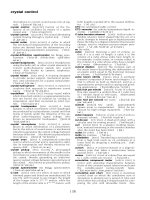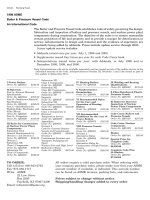Process Engineering Equipment Handbook Episode 1 Part 7 pdf
Bạn đang xem bản rút gọn của tài liệu. Xem và tải ngay bản đầy đủ của tài liệu tại đây (3.37 MB, 50 trang )
C-148 Compressors
FIG.
C-137 Single-stage turbocompressors with this OEM incorporate eight frame sizes, for suction volumes from 5000 to
250,000 m
3
/h. (Source: Sulzer-Burckhardt.)
Compressors C-149
FIG. C-138 TURBAIR™ vacuum blowers offer compact design, several different vacuum levels, low water consumption, the
best possible matching to performance requirements, a flat characteristic over a wide working range, an economical
vacuum system, good reliability, and low maintenance costs. One application was specially developed for extracting water
from paper, board, and pulp machines of all sizes. (Source: Sulzer-Burckhardt.)
C-150 Compressors
FIG.
C-139 TURBAIR vacuum blowers with this OEM incorporate five frame sizes to cover practical vacuum requirements.
(Source: Sulzer-Burckhardt.)
Compressors C-151
FIG. C-140 Expanders (turboexpanders) offer full arc admission, high efficiency, and robust design with a separate blade
carrier, and are available with adjustable stator blades for first stage. Applications include nitric acid plants and power
recovery. (Source: Sulzer-Burckhardt.)
C-152 Compressors
FIG. C-141 Turboexpanders with this OEM incorporate eight frame sizes, with rotor diameters ranging from 31 to 80 cm.
Materials are selected to suit the specific application. (Source: Sulzer-Burckhardt.)
Compressors C-153
The power input ratings of industrial applications for the compressors vary
between 2000 and 90,000 kW. (See Fig. C-142.)
With a view to economical manufacturing and stocking of the major components,
the range of compressors has been standardized. Most OEMs stock major components.
That facilitates prompt delivery of machine parts such as rotor blades and
stator blades, bearings, joints, etc., for service requirements. The systematic design
of components over the whole range of sizes enables the compressor to be adapted
optimally to the required operating conditions. Measurements conducted on the
blading of various designs and sizes ensure exact conformity of the design data with
the operating conditions.
Operating range. OEMs compete to offer the widest range of operating parameters.
How they do so is specific to their individual design philosophies. This information
source’s axial compressor program comprises two type ranges:
Type A. Compressors with fixed stator blades (FIXAX) (see Fig. C-131).
Type AV. Compressors with adjustable stator blades on all or only some stages at
the inlet (VARAX) (see Fig. C-131).
Each type range consists of 12 geometrically graduated sizes with rotor diameters
extending from 40 to 140 cm. This completely covers a suction volume range of
70,000 to 1,250,000 m
3
/h. (See Fig. C-143.)
The required compressor size and number of stages, together with the
corresponding standardized overall length, are selected according to the suction
volume and the thermodynamic head.
Type A (FIXAX). The A-type FIXAX compressor is generally used whenever the
driver is a steam turbine, a split-shaft gas turbine, or a variable-frequency high-
speed synchronous motor.
The required operating points can be attained by speed variation, and there is
basically no need for adjustable stator blades. Fixed-blade machines are also
selected for installations where only minor flow variations are required, or if the
mass flow is adapted by variation of the suction pressure, as in aerodynamic test
facilities, for example.
Type AV (VARAX). The AV series with adjustable stator blades permits a large stable
operating range at constant speed. It is therefore used for constant-speed electric
motor drive. Nevertheless, this type is being increasingly preferred for steam
turbines and single-shaft gas turbines as well. In this particular case, the stator
blade control either facilitates operation with limited speed control range (increased
reliability of operation for certain turbine types) or, in combination with the
speed control, provides an additional extension of the operating range and an
improvement of the overall efficiency at part load. Furthermore, it offers the
advantage of quick adaptation of the compressor to changed operating conditions
without acceleration of the set—a characteristic that is of great interest for the
periodic charging of air heaters in blast-furnace blowing plants. Many axial
compressors are fitted with adjustable stator blades.
Stator blade setting with electric servomotor. For a great number of processes, the
reference value of pressure or mass flow is selected at the process control panel and
transmitted to the compressor servomotor. In this case this servomotor is of the
electric type with the additional possibility of manual adjustment of the stator blades.
Stator blade control with hydraulic servomotor. If the process calls for automatic
pressure or mass flow control, the stator blade adjusting mechanism will be
operated by a synchronized pair of hydraulic servomotors.
With the exception of the stator blades and their adjusting mechanism, the same
standardized construction elements are used for both FIXAX and VARAX types.
C-154 Compressors
Performance data. Figures C-144 through C-149 (note type designation) facilitate
the selection of the
Compressor size Nominal diameter D (cm)
Number of stages z (-)
Power input P (kW)
Speed n (rev/min)
Discharge temperature T
2
(K)/t
2
(°C)
Using Capacity m
.
(kg/s)
Suction pressure p
1
(bar abs)
Suction temperature T
1
(K)/t
1
(°C)
Relative humidity of the air or gas j
1
(%)
Discharge pressure p
2
(bar abs)
Molecular mass M (kg/kmol)
Isentropic exponent k (-)
Compressibility factor Z (-)
The following factors and symbols are also used for the calculation:
FIG. C-142 Axial compressor, type AV 100–16, during erection. Two identical steam-turbine–driven machines are supplying
air to the blast furnace of a British steel works. Suction volume 560,000 Nm
3
/h, discharge pressure 6.2 bar, power input
52,000 kW each. (Source: Sulzer-Burckhardt.)
Compressors C-155
Suction volume (actual) V
.
1
(m
3
/s)
Absolute humidity x (-)
Polytropic efficiency h
P
(%)
Indices Suction branch 1
Discharge branch 2
Dry t
Wet f
Design features. The basic design offers (see Fig. C-150):
Cast casing and separate blade carrier
Casing supported by means of pendulum supports (minimum expansion forces)
or feet with keyways for the smaller frame sizes
Solid or hollow rotors, smooth-running characteristics with integrated balancing
pistons
Blading with optimal aerodynamic characteristics—with good efficiency and
specific capacity, low stressing, favorable control characteristics
Blade vibrations minimized; blade profiles and blade fixation are designed accordingly
Adjustable stator blades—of standard design—for optimum flow control
Maintenance-free, oil-free stator blade adjusting mechanism that is also protected
against the ingress of contaminants
Various bearing options
Various shaft seal options
Casings, bearing pedestals. Depending on the type of gas and the design pressure, the
casings are made of gray cast iron, nodular cast iron, or cast steel. The cast design
incorporates a rigid construction, effective noise attenuation, and aerodynamically
favorable layout of the respective ducting. The suction and delivery branches are
usually routed vertically downward. In cases where, due to the composition of the
gas and/or the pressure level, steel casings are mandatory, a welded construction
FIG. C-143 Type designation. (Source: Sulzer-Burckhardt.)
C-156
FIG. C-145 Determination of the discharge temperature t
2
. (Source: Sulzer-Burckhardt.)
FIG. C-144 Determination of the absolute humidity x and the molecular mass M
f
of the wet gas. (Source: Sulzer-Burckhardt.)
C-157
Figs. C-146 and C-147 are valid for air
at suction conditions 1 bar, 20°C,
70% relative humidity.
FIG. C-146 Performance data for type A (FIXAX). (Source: Sulzer-Burckhardt.)
FIG. C-147 Performance data for type AV (VARAX). (Source: Sulzer-Burckhardt.)
C-158 Compressors
148
149
Figs. C-146
and C-147
Fig. C-147
Fig. C-146
Fig. C-144
Fig. C-145
Performance data [type A (FIG. C-148), type AV (FIG. C-149)] for selection and performance calculation of an axial
compressor. (Source: Sulzer-Burckhardt.)
Compressors C-159
can be specified. The suction branch may then be axial, or both suction and
discharge may be routed upward or downward. In the vertical central plane, the
casing is aligned by two keyways; it is equipped with four supporting feet. It is fixed
at one end in the axial direction by one pair of feet. The other pair of feet of large
frame sizes rests on pendulum supports with spherical contact surfaces. As a result
of this, the casing can take up the thermal expansion in both the axial and lateral
direction without difficulty. This feature is particularly advantageous in the case of
FIG. C-150 Longitudinal and cross-sectional view of an AV compressor. (Source: Sulzer-Burckhardt.)
C-160 Compressors
light steel foundations, as may be found, for instance, on an offshore platform. On
small frame sizes the pendulum supports are replaced by sliding keyways.
Blade carrier, casing inserts. The blade carrier inserted in the casing is centered on
both the suction and discharge side, and is able to expand freely in the axial
direction. The diffusor and the gland inserts are also fitted as separate parts in the
casing.
The double-casing design with outer casing and blade carrier offers various
advantages:
Rigid casing construction; the clearances in the blade duct are not influenced
directly by external pipe forces.
Simple fitting of the blades and assembly of the casing parts; the top half of the
casing can be raised without dismantling the blade-adjusting mechanism.
Possibility of fitting different blade carriers, for adapting the blade duct and thus
the compressor characteristics to greatly changed operating conditions.
Optimal protection of the adjusting mechanism in the space between the casing
and blade carrier; the space is kept under suction pressure to safeguard the
adjusting mechanism against condensation and corrosion attack.
Rotor. The rotors are usually of forged solid design. In the case of larger machines
or if the moment of inertia must be minimized to limit the power requirement when
running up with an electric motor, welded hollow rotors may be used. Integrated
balancing pistons at both ends of the rotor facilitate an equalization of the axial
thrust. The careful balancing of the rotor at full speed results in highly smooth
running characteristics. If necessary, balancing can also be effected in the casing.
The labyrinth strips are caulked in the rotor.
Blading. Blading with a high degree of reaction, i.e., the increase in pressure takes
place exclusively in the impellers, is employed for the compression of lighter gases
such as helium or hydrogen.
For all other applications, such as the compression of air, blading with a lower
percentage reaction is adopted. The increase in pressure is distributed to the rotor
and stator blades. This enables the following design advantages to be realized:
Higher efficiency with lower aerodynamic loading
Widest possible control range with high part-load efficiency at constant speed
Largest possible suction volume at given speed
Increased reliability of operation due to larger radial blade clearances and the
omission of guide vane sealings
Steeper pressure volume characteristics, especially suitable for capacity control,
for the parallel operation of different compressors, for refrigeration processes, and
for exact adjustment of the blow-off line
The rotor and stator blades are normally made of 13 percent chrome steel and
machined. When handling highly contaminated aggressive air or corrosive gases,
alloys with higher chromium and nickel content may be used. The rotor blades have
rhomboidal roots and are firmly braced in an exactly defined position in the
peripheral grooves of the rotor. This is of particular importance for their vibration-
wise design. The fixed stator blades are provided with a rectangular foot. The
adjustable stator blades are made in one piece with a cylindrical shaft. The latter
is seated in a bearing bush in the blade carrier. The high damping characteristics
of this seating arrangement practically eliminate the potential for high vibration
amplitudes associated with the stator blades.
Compressors C-161
Stator blade adjusting mechanism for the AV types. The adjusting mechanism is located
in an annular space between casing and blade carrier, and is thus well protected
against contaminants and moisture. It is maintenance-free and does not require
any lubrication. (See Figs. C-151 and C-152.)
Servomotors. Two types of servomotors are available, electric and hydraulic
(Figs. C-153 and C-154).
Automatic mass flow, volume or pressure control. The adjusting mechanism is
operated by means of two hydraulic servomotors that are affixed laterally to the
casing. One of the servomotors is equipped with a positioning transmitter and the
second operates hydraulically in parallel.
The linear movement of the servomotor piston rods is transmitted directly to the
adjusting cylinder by way of two ball and socket joints.
Remote setting of reference value. One single electric servomotor is attached
laterally to the bottom half of the casing. Its driving shaft actuates a pivoted fork
FIG. C-151 Adjustable stator blade, rotor blade, and fixed stator blade with intermediate piece.
(Source: Sulzer-Burckhardt.)
FIG. C-152 Stator blade adjusting mechanism. (Source: Sulzer-Burckhardt.)
C-162 Compressors
positioned on either side of the casing in maintenance-free bearings. This fork in
turn moves the adjusting cylinder in the axial direction.
Adjusting cylinder. The adjusting cylinder of welded design can move in the
axial direction and is dry-seated. There is no restriction of heat expansion in any
direction. U-shaped guide rings are provided on the inner side in which the
adjusting levers are engaged.
Stator blades. The adjusting levers provided on the end of each stator blade
shaft are connected to the guide rings of the adjusting cylinder by means of pivoting
sliders. The axial movement of the cylinder is converted into a rotating movement
of the stator blades.
The self-lubricating bearing bushes of the blade shafts are seated in the radial
holes of the blade carrier. O-ring packings prevent the ingress of contaminants into
the stator blade seating.
Shaft seals. Labyrinth seals are used for the standard models. The stainless steel
labyrinth strips are caulked on the rotor and are replaceable. In case of rubbing
FIG. C-153 Electric servomotor. (Source: Sulzer-Burckhardt.)
FIG. C-154 Hydraulic servomotor. (Source: Sulzer-Burckhardt.)
Compressors C-163
due to unbalance, the friction-induced heat is immediately passed to the massive
stator, thus avoiding distortion of the rotor. Gas-tight shaft seals and standstill seals
can be fitted for special requirements. See Fig. C-155.
Journal and axial bearings
Journal bearings. In the standard version, i.e., with the compressor rotor solidly
coupled and the rotor thrust transferred to the axial thrust bearing of the prime
mover or the gear, the bearing housings are equipped only with journal bearings.
Two-lobe bearings are provided for the lower speed range; tilting pad journal
bearings are generally used for the higher speeds of the smaller frame sizes for
reasons of stability. The slight curvature of the adjusting plates allows the bearings
to be set accurately on erection. The bearings are firmly held in position by the
bearing housing top half. See Figs. C-156 through C-158.
Two-lobe bearings are suitable for both senses of rotation, while tilting pad
bearings are essentially for only one direction, although they can tolerate running
backward with a somewhat reduced load capacity.
Axial thrust bearings. If a flexible coupling is selected between driver and driven
machine, the bearing housing can accommodate the necessary tilting pad thrust
bearing. The purpose of this bearing is to absorb the remaining thrust of the
machine and any significant axial friction thrust of the coupling due to sharp
FIG. C-155 Labyrinth shaft seals. (Source: Sulzer-Burckhardt.)
FIG. C-156 Multisegment journal bearing with four tilting pads. (Source: Sulzer-Burckhardt.)
Compressors C-163
due to unbalance, the friction-induced heat is immediately passed to the massive
stator, thus avoiding distortion of the rotor. Gas-tight shaft seals and standstill seals
can be fitted for special requirements. See Fig. C-155.
Journal and axial bearings
Journal bearings. In the standard version, i.e., with the compressor rotor solidly
coupled and the rotor thrust transferred to the axial thrust bearing of the prime
mover or the gear, the bearing housings are equipped only with journal bearings.
Two-lobe bearings are provided for the lower speed range; tilting pad journal
bearings are generally used for the higher speeds of the smaller frame sizes for
reasons of stability. The slight curvature of the adjusting plates allows the bearings
to be set accurately on erection. The bearings are firmly held in position by the
bearing housing top half. See Figs. C-156 through C-158.
Two-lobe bearings are suitable for both senses of rotation, while tilting pad
bearings are essentially for only one direction, although they can tolerate running
backward with a somewhat reduced load capacity.
Axial thrust bearings. If a flexible coupling is selected between driver and driven
machine, the bearing housing can accommodate the necessary tilting pad thrust
bearing. The purpose of this bearing is to absorb the remaining thrust of the
machine and any significant axial friction thrust of the coupling due to sharp
FIG. C-155 Labyrinth shaft seals. (Source: Sulzer-Burckhardt.)
FIG. C-156 Multisegment journal bearing with four tilting pads. (Source: Sulzer-Burckhardt.)
C-164 Compressors
temporary differential expansion between rotor and casing. To provide easy access
and reduce the overhang, it is preferably mounted on the free shaft end.
The tilting pads are supported on load-equalizing segments that allow angularity
of the shaft up to 0.3 percent.
Because the tilting pads are supported eccentrically, thrust bearings are suitable
for only one direction but tolerate a reversed rotation at a reduced load capacity.
Solid coupling. It is this OEM’s normal practice to make extensive use of solid
couplings allowing the use of only one axial thrust bearing for single- or multiple-
casing arrangements.
An intermediate shaft, flexible enough to allow for considerable misalignment, is
inserted between the two shaft ends of the machines to be coupled together (Fig.
C-159). In case of motor-driven units, the normal technique is to use single helical
gears provided with thrust collars on the pinion shaft, as shown in Figs. C-160 and
C-161. The thrust collars not only neutralize the axial thrust created by the
meshing of the teeth cut at an angle to the axis of the shaft, but also transmit
FIG.
C-157 Two-lobe journal bearing. (Source: Sulzer-Burckhardt.)
FIG. C-158 Kingsbury-type thrust bearing with self-equalizing pads with directed lubrication.
(Source: Sulzer-Burckhardt.)
Compressors C-165
the unbalanced axial thrust of the high-speed rotor train to the thrust bearing on
the low-speed wheel shaft. Good gear meshing requires parallelity of gear and
pinion shaft and automatically ensures parallelity of the contact surfaces of thrust
collar and wheel rim. The slight tapering of the thrust collars is responsible for the
formation of a wedge-type oil film creating a pressure zone spread out on an
enlarged surface with a pressure distribution very similar to that of a standard oil-
lubricated journal bearing.
The relative motion between the two contact surfaces of the thrust collar system
is a combination of rolling and sliding and takes place near the pitch circle diameter,
resulting in a very small relative velocity. The thrust transmission is therefore
conducted with minimal mechanical losses. The considerably reduced losses of
the single thrust bearing on the low-speed shaft as compared with the high losses
of individual thrust bearings on the high-speed train lead to a substantial power
saving. This low-speed bearing can also be more amply dimensioned to provide a
much higher overload capacity.
For direct turbine-driven compressor trains, the thrust bearing is usually located
in the turbine. Also in this case solid couplings with flexible intermediate shafts are
much preferred.
This coupling arrangment avoids heavy overhung gear couplings that are usually
responsible for not clearly defined lower critical speeds and for the phenomena of
torque lock leading to additional loading of the axial thrust bearing. The resulting
axial friction forces can become quite substantial if insufficient attention is given
to the cleanliness of the lubricating oil.
Centrifugal compressors
Centrifugal compressors made by this information source are available for the
compression of various gases within a flow range of about 0.6 to 60 m
3
/s and
pressures up to 700 bar. They are used in the most varied applications, mainly in
FIG.
C-159 The solid quill-shaft coupling conforms to API 671 standard and consists of the quill
shaft and the two hubs hydraulically fitted onto the shaft ends of the connected machines. On
each coupling side, an equal number of tie bolts for axial fixation and tapered dowel pins for
torque transmission and centering ensure a clearly defined connection. Balancing as a complete
assembled unit and correlative marking enable removal and remounting of this intermediate shaft
with the connected rotors remaining in place, without affecting the balancing quality and vibration
behavior of the complete string. (Source: Sulzer-Burckhardt.)
C-166 Compressors
the fields of process engineering, chemical industry, and mineral ore processing, as
well as oil and gas production. See Fig. C-127.
Units made by this information source have power inputs varying between a few
hundred kilowatts and nearly 40 MW.
To minimize design lead time and ensure economical manufacturing and stocking
of the major components, the range of these compressors has been standardized to
an optimum extent. The constant geometrical ratio between the frame sizes allows
compressors to be assembled to different specifications with the minimum inventory
of component parts, diminishing the investment on spare parts. It also permits
comparison and forecast of performance and stresses within the series of frame
sizes. Figure C-162 shows a section through a centrifugal axially split compressor.
Type range. The standardized range of horizontally split casing types (see Fig.
C-131) extends to eight frame sizes for this OEM source including three pressure
ranges for each frame size up to 70 bar and is designed for appropriate turndown.
FIG. C-160 Method of axial thrust transfer in a single helical gear with thrust collar. (Source:
Sulzer-Burckhardt.)
FIG. C-161 Transfer of external forces. (Source: Sulzer-Burckhardt.)
Compressors C-167
An appropriate selection of impellers and diffusers enables the compressor stages
to be matched to any specified operating data. See Figs. C-163 through C-167.
The barrel-type design is suitable for discharge pressures of up to 700 bar. It has
vertically split casing with end cover and autoclave cover and horizontally split
internal casing for easy assembly and dismantling. Option of intermediate nozzles
for connecting to intercoolers or for side-stream intake or extraction. The internal
components, including the horizontally split internal casing, autoclave cover,
diaphragms, and rotor with bearings and seals, are assembled outside the barrel
casing; the internal clearances can then be checked exactly prior to final assembly.
Compressor design: adaptability of standardized product range. The different ways of
adapting standard designs to varied operating conditions are described as follows:
Adapting to different specific flow conditions. The basic dimensions of the
components and parts of compressors such as casings, impellers, diffusers, and
bearings are standardized by using a constant scale factor between the different
frame sizes. As can be seen in Fig. C-165, this factor is 1.25 for the casing sizes,
1.12 for impeller diameters, and even smaller for certain dimensions of internal
parts. This system permits the assembly of various compressors complying to
specified data by using a minimum number of predesigned parts. Moreover, it
ensures accurate forecasting of performance interpolated from other frame sizes.
The eight frame sizes cover a range between 0.5 and 60 m
3
/s. The range of higher
FIG. C-162 Section through a horizontally split axial compressor. (Source: Sulzer-Burckhardt.)
C-168 Compressors
suction volumes above about 25 m
3
/s and up to 350 m
3
/s is covered by 12 frame sizes
of axial compressors, where a scale factor of 1.12 is used.
Adapting to different specified pressures. This information source’s models (R,
RZ, and RS) can be equipped with casings made of gray cast iron, nodular cast iron,
or cast steel which, depending on the frame size, makes them suitable for standard
design pressure classes of 6, 16, 25, 40, or 64 bar. The RB, RBZ, and RBS casings
are invariably made of fabricated or cast steel to cover the standard pressure range
of up to 700 bar.
Adapting to different process conditions. The process industry has an ever-
changing range of requirements concerning the arrangement of external casing
nozzles, either when intercooling is needed to limit temperature during compression
or intermediate inlets have to be provided for side-streams. The standard design is
very flexible in this respect.
CENTRIFUGALS WITH HORIZONTALLY SPLIT CASINGS
Series R: straight-through compressor without provision for intercooling
Series RZ, RZ2: compressors with one or two pairs of intermediate nozzles for
connecting to one or two intercoolers
Series RS, RS2: compressors with one or two intermediate inlet nozzles for one
or two side-streams
CENTRIFUGALS WITH VERTICALLY SPLIT CASINGS
Series RB: straight-through compressor without provision for intercooling
Series RBZ: compressor with one pair of intermediate nozzles for connection to
an intercooler
Series RBS: compressor RB with additional inlet or outlet
FIG. C-163 Selection chart for centrifugal compressors of the R and RZ series. (Source: Sulzer-Burckhardt.)
Compressors C-169
FIG. C-164 Typical series designations for centrifugal compressors. (Source: Sulzer-Burckhardt.)
C-170 Compressors
Building block system. Each compressor frame size exists in different
standardized lengths to accommodate different numbers of stages. With cast
casings, adjustments of the pattern are made using a modular technique whereby
spacing rings are fitted between standardized pattern parts of the casing to alter
the length (Fig. C-167).
When the head required is more than that practicable within one compressor
body, two or more casings can be connected in series to form a train.
Design features
Casing. Depending on the required pressure class and the type of gas, the
horizontally split casings of the series R, RZ, and RS are made of gray cast iron,
nodular cast iron, or cast steel, unalloyed or alloyed. See Fig. C-168 for a section
through a horizontally split centrifugal compressor and Fig. C-169 for a section
through a barrel centrifugal compressor. All suction, intermediate, and discharge
nozzles are normally facing downward to facilitate inspection without disturbing
the process pipe connections. Optionally they can be arranged facing upward. In
the case of flammable or toxic gases, the horizontal division flange can be provided
FIG. C-165 Standardized range of centrifugal compressors based on eight geometrically similar frame sizes. Each frame
is designed to accommodate three different impeller diameters and different impeller types. (Source: Sulzer-Burckhardt.)
FIG. C-166 Standard pressure classes. (Source: Sulzer-Burckhardt.)









